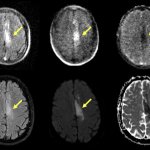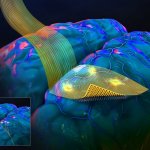
News • Thermogenesis
How Alzheimer's (quite literally) fries the brain
Researchers have shown that aggregation of amyloid-beta, one of two key proteins implicated in Alzheimer’s disease, causes cells to overheat and ‘fry like eggs.’

Researchers have shown that aggregation of amyloid-beta, one of two key proteins implicated in Alzheimer’s disease, causes cells to overheat and ‘fry like eggs.’

Researchers visualize brain inflammation using diffusion-weighted MRI. This detailed "X-ray" of inflammation cannot be obtained with conventional MRI, but requires data acquisition sequences and special mathematical models.

A new way of differentiating healthy from diseased cells could pave the way for more personalised treatment for patients diagnosed with glioblastoma multiforme (GBM), a common and aggressive type of brain tumour.

A research team in Spain and the US has created 3D-printed acoustic holograms to improve the treatment of diseases like Alzheimer's and Parkinson's, among others.

Ultra-powerful 7T MRI scanners could be used to help identify patients with Parkinson’s disease and similar conditions who are most likely to benefit from new treatments, say scientists.

Swiss researchers discovered how different cell types in cortex change their activity during general anesthesia, helping to understand how unconsciousness may be induced.

Dr Christina Malamateniou spoke to The European Society for Magnetic Resonance in Medicine and Biology about the recent review she led to help make MRI brain scans more accessible to autistic people.

An international team has for the first time demonstrated that nerve signals are exchanged between clogged up arteries and the brain.

A team led by scientists from Amsterdam have combined MRI and microscopy to produce 3D images of two entire brains with a previously unmatched level of detail.

Portable MRI machines detected ischemic strokes, or strokes caused by clotting, in 90% of patients scanned.

Scientists use miniature brain models to understand how a mutated gene affects brain development.

For people with atrial fibrillation, one of our most common cardiac disorders, dementia risk is elevated.

Scientists are developing a novel method for treating brain haemorrhages which it is hoped could reduce the risk of brain damage and disability and increase patients’ chances of survival.

Researchers have found another long-term complication associated with Covid-19 infections: peripheral neuropathy during and following their bouts with the virus.

A wireless sensor could offer doctors a way to monitor changes in brain chemistry without requiring a second operation to remove the implant.

A brain-computer interface array featuring microneedles affixed to a flexible backing allows arrays of micro-scale needles to conform to the contours of the brain.

A significant number of Covid-19 neurological complications – such as fatigue, headache, and cognitive impairment – are ultimately reversible, according to new research.

A new type of AI companion is being designed to aid memory recollection, boost confidence and combat depression in people living with Alzheimer’s disease and other types of dementia.

Using a novel probe for functional magnetic resonance imaging, researchers have devised a way to monitor individual populations of neurons and reveal how they interact with each other.

Scientists have developed a neutron-based method to study brain slices and gain a better understanding of neurological diseases.

When combined with genetic risk factors, the test was up to 93 percent accurate at identifying people at risk of Alzheimer's dementia.

GenesisCare announced the establishment of the Accuray CyberKnife S7 robotic accelerator that delivers radiosurgery treatment guided by AI and synchronized with real-time imaging.

Nerve damage in multiple sclerosis can be detected via the concentration of neurofilament light chain in the blood. This could offer valuable information on future disease course and therapy effectiveness.

Researchers in Zurich have developed a fluorescent orexin biosensor to observe on of the brain's signaling molecules "live" to gain insights into constant daytime sleepiness (narcolepsy).

Children's National Hospital successfully performed the first-ever high-intensity focused ultrasound surgery on a pediatric patient with neurofibromatosis. This is the youngest patient to undergo HIFU treatment in the world.